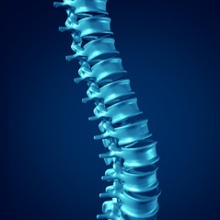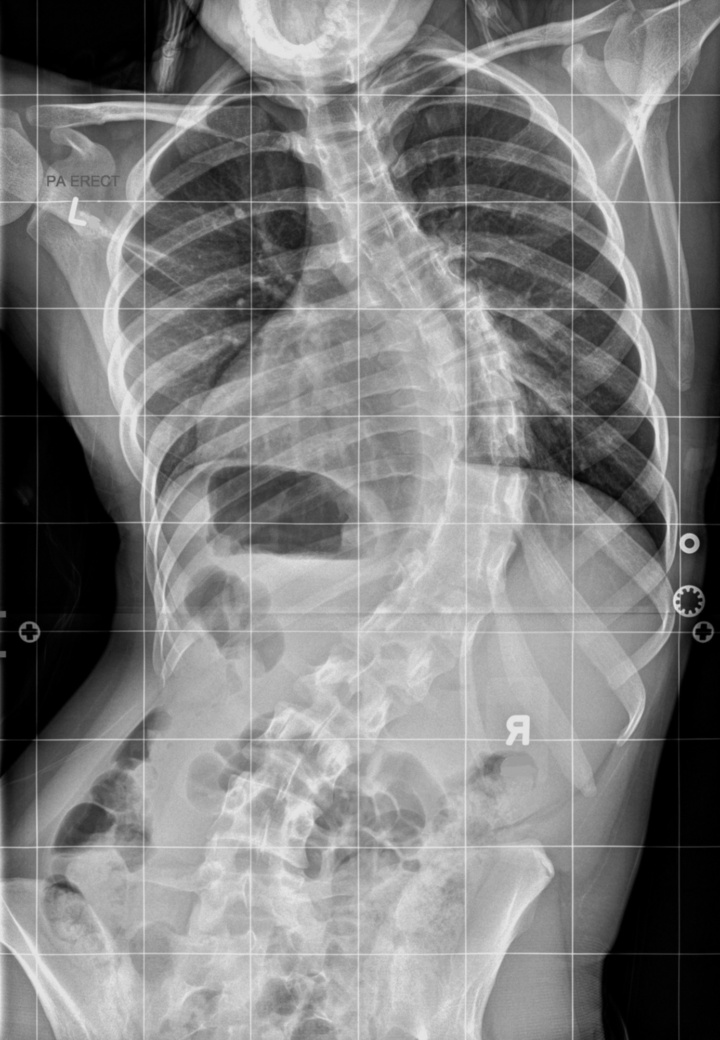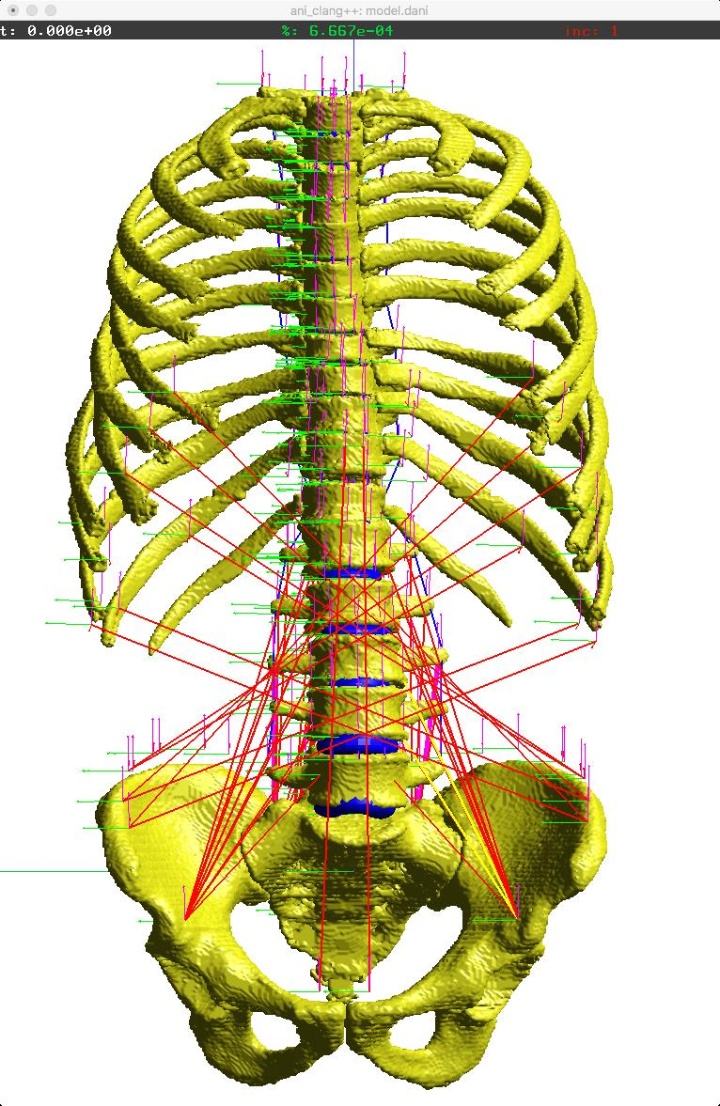Physicist Syn Schmitt and his team are working on a simulation that will model the spinal column as realistically as possible in order to provide surgeons with the ability to better estimate the value of certain operations. To date, the findings from the simulations, which were generated at the University of Stuttgart’s SimTech, a Cluster of Excellence for Simulation Technology, have not yet found their way into therapeutic practice. However, the junior professor from the Institute of Sports Science is working with colleagues in Australia to improve the treatment of spinal curvatures.
The spinal column is a complex structure: it is the central supporting component of the human body, serves as a shock absorber, distributes the weight of the body to the legs and enables us to walk upright. This multi-functionality is the result of a complex interplay between bones, spinal discs, tendons, ligaments and muscles. And, although research into the spinal column is ordinarily the preserve of physicians and biologists, engineers and researchers from related disciplines have been studying its mechanical properties for quite some time now. As far back as 50 years ago a paper was published in which the spinal column was described as two oscillatory masses between which a shock absorbing spring is positioned. “One can accept this as an – albeit very simplistic – model of the spinal column”, says Schmitt. Since then, researchers around the world have developed new spinal models. “Now, there are loads of them”, Schmitt explains, “although they differ widely in terms of usefulness.”
Spinal models based on the same principles used by engineers to simulate the stability and dynamics of bridges are very common. Models based on this socalled finite element method (FEM) employ a lattice of simple geometric bodies to represent the load-bearing elements of a bridge. The loads to which a bridge is subjected through winds and traffic can be calculated based on the interactions between the various lattice elements. In simple terms, if none of the parameter values for local stress forces exceeds certain set limits during the simulation, then the bridge is deemed to have passed the stress testing. “The FEM can also be applied to the spinal column”, says Schmitt. “These days it works pretty well, although the limitations of these models become apparent when one tries to simulate dynamic processes.” The load changes that occur during sequential standing, sitting down and standing back up, for example, are not easy to calculate using FEM-based models.
The Spinal Disc as a Simulator
That is why researchers at the SimTech Cluster of Excellence in Stuttgart are taking a different approach. The load distribution between structures can be calculated using the spinal column model developed there over the past eight years. “For example, we can calculate the forces operating on a ligament or disc during a given movement”, the junior professor explains. The simulations are programmed with details of the backbone geometry including all the spinal discs, ligaments, tendons and muscles and their material properties. “That would not have been achievable without the interdisciplinary collaboration at SimTech”, Schmitt continues.
The original spinal disc model was developed by a team working under the auspices of Wolfgang Ehlers, Professor of Continuum Mechanics at the Institute of Applied Mechanics and Managing Director at SimTech. The fact that the model calculations are executed more rapidly now – just a few seconds per disc and load case rather than the five hours it used to take – is thanks to the work carried out by the group headed up by mathematician Professor Bernard Haasdonk. Another team led by Wolfgang Nowak, Professor of Stochastic Simulation and Safety Research for Hydrosystems, helped to improve the means of estimating the reliability of the simulations. Schmitt’s work group then focused on the spine as a complete locomotor system, i.e., on the mechanical interplay of the individual components.
Computer Supported Treatment
Schmitt and his team are currently collaborating with scientists in Australia, to investigate the explanatory power of the Stuttgart spinal model in relation to a specific medical problem known as scoliosis or spinal curvature. In sufferers of this condition, the spinal column is laterally displaced from the centre line and the individual vertebrae are twisted to a greater or lesser degree. Symptoms first appear in the childhood years and often worsen during puberty, although sufferers usually only experience severe disability in adulthood. Severe cases are, therefore, treated by inserting spinal supports during the growth phase to force the backbone to maintain the correct form.
In Brisbane, simulation experts at the Queensland University of Technology and medical physicians from the Centre for Children’s Healthcare have been collaborating closely to determine the precise number of vertebrae that actually require bracing in specific cases with the aid of simulations. “Our Australian colleagues are utilising a patient-specific finite element model for this”, says Schmitt: “And we use their results to compute load cases that also factor in the relevant muscles.” These results are then fed back into the Australian FE model where they help to simulate realistic movements. “Our hope”, says Schmitt, “is that we can achieve a better prognosis quality for individual patients than has been possible till now.”
For, implants sometimes fail under load because the concomitant forces are far greater than those that occur during walking or sitting. The German-Australian team have recently simulated their first concrete case, and the intention now is to use this as the starting point for a long-term project. The Stuttgart-based researchers would very much like to find an additional medial research partner in Germany or elsewhere in Europe. Although, as Schmitt admits, the “approach is still very unusual from a physician's perspective.”
Michael Vogel
- Prof. Wolfgang Ehlers, Institute of Applied Mechanics, Department of Continuum Mechanics, phone +49 711 685-66346, E-Mail, Website
- Prof. Bernard Haasdonk, Institute of Applied Analysis and Numerical Simulation, phone +49 711 685, E-Mail, Website
- Jun.-Prof. Syn Schmitt, Biomechanics and Biorobotics, phone +49 711 685-60484,
E-Mail, Website - Prof. Wolfgang Nowak, Institute for Modelling Hydraulic and Environmental Systems, Department of Stochastic Simulation and Safety Research for Hydrosystems, phone +49 711 685-60113, E-Mail, Website
- SimTech Cluster of Excellence




